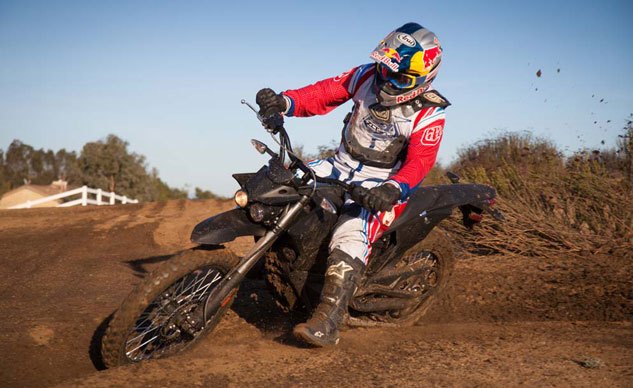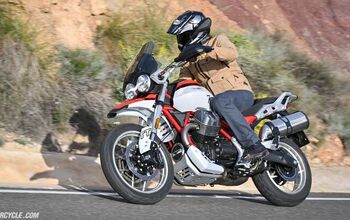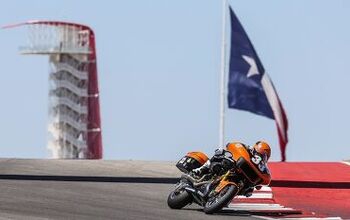2014 Zero FX Dirt Review – Video

Street-legal dirt fun in the (big) backyard
For 2014, Zero streamlined its product offerings to focus on its core products: the S, SR, DS, and FX. With the dirt-focused MX electric bike gone from the lineup, the FX has become the de-facto dirtbike currently in the Zero range.
2014 Zero FX
| Engine | 19/20 |
| Suspension/Handling | 13/15 |
| Transmission/Clutch | 10/10 |
| Brakes | 8.5/10 |
| Instruments/Controls | 4/5 |
| Ergonomics/Comfort | 9/10 |
| Appearance/Quality | 8.5/10 |
| Desirability | 7.5/10 |
| Value | 4/10 |
| Overall Score | 83.5/100 |
It might seem a slight stretch to call the FX a dirtbike, as it’s largely billed as a city bike for hooligan antics (meaning yes, it can wheelie), but seeing as it’s fitted with knobby-ish tires and looks largely like a dirtbike, it has creditable off-road chops.
2013 Brammo Empulse R vs Zero S ZF11.4
While most coverage of electric motorcycles has focused on streetbikes, the use of e-bikes in the dirt has been underreported. Range limitations can be less of an issue when riding off-road, but the most significant benefit to going electric in the dirt is that their relatively silent operation allows their use almost anywhere.
To see just how capable the FX performs in the dirt, Zero VP of Global Marketing, and off-road racing legend, Scot Harden, invited E-i-C Kevin Duke and yours truly to come ride the FX with him. The location? A trail-type track in back of Harden’s house.
New For 2014
First some background info on the FX. If you’ve been following MO for a while, you’ve probably read about my experience racing the FX to the clouds at Pikes Peak, and for an entire 24-hour road race. However, both times the bikes I rode were modified.
The FX is the only bike in Zero’s lineup with modular battery packs, meaning battery swaps can be made quickly and easily. Available with either one 2.8kWh pack or two, each weighs about 45 lbs. The motor is equally as impressive as the batteries, able to pump out an impressive 70 ft-lb of torque and 44 hp. The three-phase, 420-amp, brushless controller, meanwhile, is similar to the units found on the S and DS models.
These features haven’t changed from last year’s FX. However, the upgrades seen this year are significant. From a visual standpoint, gone is the single round headlight of before, replaced with dual projector beam headlights that really complement the look of the bike. Staying at the front, the FX, along with the entire 2014 Zero line, gets a new bespoke gauge cluster. It’s cleaner and more elegant, while providing heaps more information to the rider than before. A new seat is also more sculpted with the lines of the bike.
After these visual changes, the upgrades become more functional. Wider head bearings and 43mm forks (compared to 38mm last year) make for a more robust front end, while front and rear brake rotors grow to 240mm (from 221mm). The rear also receives a new caliper and master cylinder for improved feel, alleviating a complaint about Zeros in the past. Finally, the swingarm has been revised with new bearings to achieve better torsional rigidity, according to Zero. All told, the FX is the lightest bike in the Zero fleet, weighing in at 280 pounds – that’s only about 25 pounds heavier than a Honda CRF250X that carries no street equipment.
Playing In The Dirt
Our day in the dirt was comprised of three riders of vastly different skill sets. On one end we had Harden. The multiple Baja champ, Dakar competitor, three-time ISDE medalist and AMA Hall of Famer has stacks of first-place trophies in his garage. Needless to say, he rode with his FX in its full-power mode.
Then there was Duke. Raised in the dirt, he’d been riding off-road since his early days of motorcycling, though never anywhere close to Harden’s level. He experimented with different power settings all day. As for yours truly, I can count the amount of times I’ve ridden a dirtbike on two hands…and have at least three fingers left over. My dirt skills are approximately the inverse of my ability on pavement. Consequently, I set the maximum torque output to 0%. The poorly labeled setting doesn’t mean the bike made zero power, but rather the overall available power was reduced to its lowest predetermined setting by Zero.
Nonetheless, the above paragraph highlights the uniqueness of the Zero line, including the FX. All of the bikes have three different power modes — Sport, Eco, and Custom — and as the name would imply, the Custom setting allows a rider to use the Zero app on their smartphone to adjust a number of different settings to suit their needs or skills at the push of a button. It’s a unique feature that truly does make one motorcycle suitable for a multitude of riders. As Kevin noted, “Wanna teach your newbie friend or teenage son to ride in the dirt? Dial the power down and let him or her learn to ride without scaring them off with too much power, then slide it to higher levels as skills advance.”
Once we were rolling in the dirt, the difference between the three bikes was clear from my vantage point. At full power, Harden was spinning the rear and flinging dirt in the air at the flick of his wrist. Duke, too, was impressed by the amount of power available from the FX. It showed in the amount of times he got sideways, especially in Sport mode.
Meanwhile, in my drastically reduced power setting, initial power delivery was so docile, whacking the throttle wide open coming out of turns was often met with forward movement instead of a spinning wheel. It was only on the dry, sandy stuff where the wheel started spinning. Traction is normally a good thing, but there’s no denying getting a little sideways is loads of fun. In higher torque levels, it was sometimes difficult to get the rear tire hooked up in loose soil conditions because of the instant-on power delivery.
Throughout the day, Kevin experimented with dropping power levels, starting at 70%, then 50%, until eventually 25%. With each drop, the difference was felt mostly only at wide-open throttle, but the initial power application became much easier to lay down smoothly. Even at 25% Kevin was impressed by how much grunt was still available. “It surely didn’t feel like 75% less power,” he noted.
From my newbie point of view, not having to worry about the clutch and changing gears allowed me to focus more of my attention on the specifics of dirt riding. At the same time, neither of my more esteemed riding mates were longing for a set of gears all day long. However, when riding in, say, an enduro-like environment, Duke did comment that “experienced dirt riders might miss a clutch lever, which can help loft a front wheel in an instant to clear obstacles.”
Otherwise, the FX feels narrow between the knees like a standard internal combustion engine (ICE) dirtbike. Its handlebar is wide and gives ample leverage, and factory etched marks come in handy when rotating the bar within the clamps to suit personal ergonomics. The leverage is a good thing, as Duke noticed the FX felt “slightly top heavy compared to a 250F motocrosser. Almost like an ICE dirtbike fitted with a large fuel tank.”
One of the big talking points with the new Zeros is the upgrade to 43mm forks. While the backyard course we rode was flat in comparison to a MX track, Duke noticed the fork did a commendable job of “following a rider’s direction without deflecting over bumps.” Even Harden was impressed with the new fork, focusing instead on dialing the shock to suit his tastes. Each end has adjustments for both compression and rebound damping, while the shock includes a preload adjuster. The suspension performed well in the trail-type environment we rode in, using its 9 inches of travel to absorb moderate off-road obstacles, but it would be too soft for serious moto environments if ridden aggressively.
Brakes were also upgraded this year, with the 240mm disc at both ends mated to steel-braided lines. The front provides good feel and stopping power, even for my skills, and considering the pseudo-knobby tires fitted to the FX, I always felt in tune with how much more squeeze I could give before lockup. Maybe even more impressive is the rear, which finally provides good feedback instead of the wooden feeling I’ve experienced before. This gave me greater confidence to brake slide into turns, and Harden noted the better feeling is a great aid when using the rear to steer the motorcycle.
What about the batteries?
With anything electric, the big question mark always surrounds the batteries. After romping around in the morning, and at different power settings, Harden’s machine still had 88% left after our first two sessions, which is very impressive considering his greedy throttle hand. My bike, set to the lowest power level, had a whopping 92% charge remaining. After a quick plug-in while we ate sandwiches for lunch, all three bikes continued for the rest of the day, all with plenty of juice left over.
Street-oriented electric bikes like the Zero S or the Brammo Empulse can consume much of their battery simply riding to a preferred riding destination – highway miles quickly drain batteries. But with the FX, Duke notes, “Its dirt intentions are mostly envisioned to be used after being transported to a riding area, and energy consumption in that environment should last for most or all of a day off-road riding.” Also, because it is street legal, you can easily jump off the trail, head towards pavement, and grab a bite to eat. Recharging a fully depleted battery via your standard 110-volt wall outlet could take as much as eight hours. With an extra-cost adapter, refills at a CHAdeMO station could take as little as one hour.
Ultimately, the big takeaway is the FX is a fine dirt-worthy motorcycle, no matter the skill level. The fact it just happens to be electric almost becomes a side note. Hop on the forums or talk to a FX enthusiast, and they’ll echo our thoughts about its dirt capabilities with stories and pictures of their own. In fact, if equipped with proper knobby tires, Harden feels the FX could more than hold its own around his backyard track. He even goes so far as to say, “I’d race anybody on a 250F on this course.”
The FX’s $11,990 MSRP (when equipped with both battery packs) will naturally relegate it to niche status, though as of this writing it is still eligible for a $900 rebate if you live in California (check the Zero website for rebates in your state).
It’s not for everybody, but “This could be the ideal machine for strapping to the bumper of an RV,” Duke says, “especially if parked in a campground with electricity for overnight charging.”
Related Reading
2013 Brammo Empulse R vs Zero S ZF11.4 – Video
2015 Energica Ego Review – First Ride
Dual-Sport Shootout: Electric vs. Gasoline!
2010 Electric Motorcycle Shootout
All things electric on Motorcycle.com

Troy's been riding motorcycles and writing about them since 2006, getting his start at Rider Magazine. From there, he moved to Sport Rider Magazine before finally landing at Motorcycle.com in 2011. A lifelong gearhead who didn't fully immerse himself in motorcycles until his teenage years, Troy's interests have always been in technology, performance, and going fast. Naturally, racing was the perfect avenue to combine all three. Troy has been racing nearly as long as he's been riding and has competed at the AMA national level. He's also won multiple club races throughout the country, culminating in a Utah Sport Bike Association championship in 2011. He has been invited as a guest instructor for the Yamaha Champions Riding School, and when he's not out riding, he's either wrenching on bikes or watching MotoGP.
More by Troy Siahaan




























































Comments
Join the conversation
I WANT ONE!!! Or three. :)
So my question is this: How far will it go on single track out in the forest, maybe some snow and mud, rocks and uphills? Not racing, just riding? Is it a good trail bike or is the range just not quite there? Also, what's the fin thing under the front of the bike? looks very susceptible to getting banged by a rock, is there a skidplate for it?